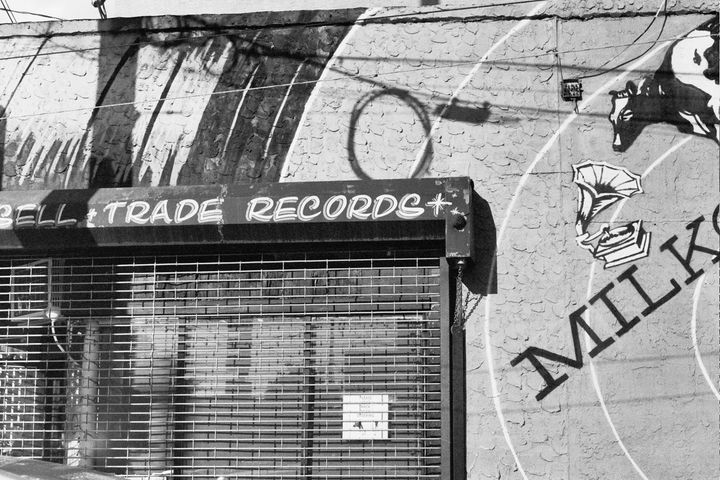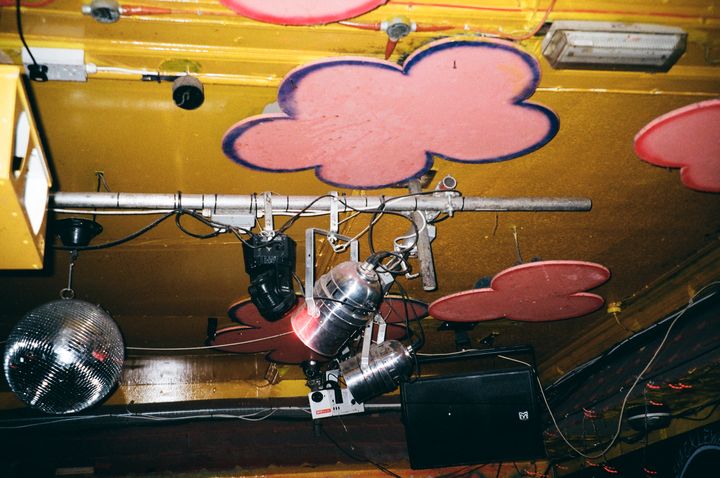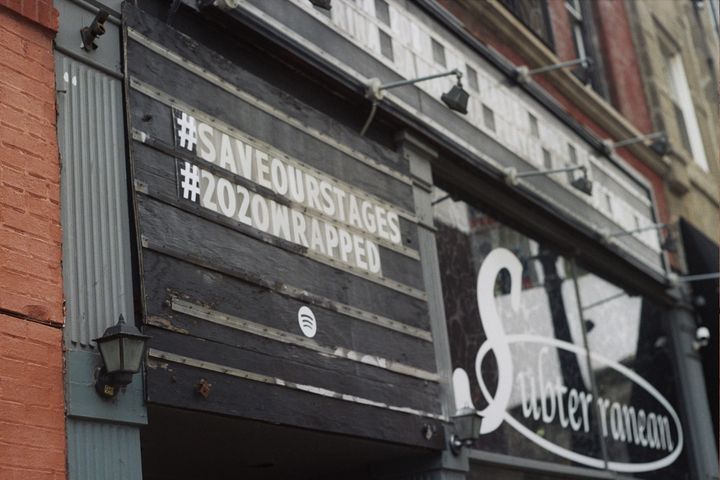on diminishing newness

In an episode of Indiecast, one of those guys said last year was one of the most memory-holed years in history for new albums. For me personally it’s less pre and post pandemic, but more before and after the realization that things are not going back to normal for a long time. The line for me is specific. I remember Slow Mass talking about rescheduling a tour for late May and at the start of the month, as soon as that became obviously not viable, my brain shifted. Even with the benefit of some definite time markers— moving, a traditional semester timeline even if class was online— my memory still falls mostly pre and post May. Lots of stuff in the early year ended up feeling like so long ago almost immediately upon release. Albums I thought came out in like February actually came out in April. It was a mess. So I wanted to talk about how we talk about music because it’s more than just press. It’s also a reflection of the way we, as fans and people invested in it, experience music and how it’s rooted in our lives and I love that stuff. So let’s get into it.
There’s a lot of discussion around the idea that new albums aren’t treated as “new” for very long— or as long as people think they should be, at least. Three days, a week, two weeks maybe, then it’s old news. Compounded with the idea that albums are valued less and less and discussion of TikTok, an app whose music industry marketing value is literally tied to successive internet trends, is at what feels like a critical mass, it sure does feel like that’s the case. I’ve been thinking about this for a while and knew I wanted to write about it, but I kept coming to the same thought:
Is this actually happening or are we just perceiving an existing trend differently while losing our collective hold on time in a pandemic?
The tldr; on this piece is, well, I think it’s both. As we get deeper into streaming focused music and further from traditional albums and more tangible media there is an obvious disincentive to look at new music with the same drawn out focus as in the past.
The way we discuss music is inherently tied to the way we listen to it. Right now that’s Spotify and short form release. A growing importance put on singles with the hope of being picked up by TikTok or by a Spotify editorial playlist only exacerbates our attention span with art.
The destruction of music’s value over time is something a bit outside the scope of this article, but I think in music journalism there is a huge chasm between what we valorize from the past, or in the wake of artists’ deaths, against what is valued in relation to the industry. I’ve talked about culture economics before in an article about the financialization of music and I think when we talk about how we discuss art it’s hard to divorce that from the way we experience arts industries.
In an essay about approaches to studying the value of arts and culture, cultural economist Erwin Dekker discusses first one of those approaches known as arts and commerce approach. Essentially this theory breaks down into the belief that markets will never create art of high quality and that autonomy of arts is necessary for arts to thrive. He goes on to explain the belief that art doesn’t coexist with the economic organization and planning of the 1950s very well and, according to economist John Kenneth Galbraith, Americans (artists included) have been conditioned to believe art is a “frivolous luxury” which should not take precedence over things which serve the “technostructure.”
And I think this is true and a huge reason why it’s easier to sell a 10 year anniversary piece of something that at the time was subversive and challenging than it is to sell an article on a current artist who is challenging in a similar way. I’ve been thinking about it in light of the absolutely tragic death of SOPHIE, too. We look at someone like that, this truly iconic, special artist, and we know that in life the reverence afforded to her pales in comparison to what it should have been— pales in comparison to the last few days of outpouring of love. Yet it’s also obvious to me that outlets who cover music and who are running pieces about SOPHIE now will continue to not afford that reverence and time to trans musicians or Black musicians or anybody who does not serve the technostructure and comfortable culture because that’s just what’s easier. Even articles about hyperpop artists, who are a genuinely exciting group of people, are discussed all too often through the lens of a Spotify playlist first and as individuals second. It serves corporate interest to push that they’re valuable because of the playlist or at least made legitimate by this playlist. There are more interesting stories to be told. There are more challenging stories that must be told and I bristle against the idea that you must cover what makes them industry viable to tell a compelling story about artists.
The prioritizing of corporate interest isn’t new, but when our method of consumption has skewed so far into short form and intentionally secondary, the cultural value of art is diminished. That diminishing has brought us to a place where we spend less and less time talking about what’s new and exciting. There’s jokes about how people talked about an artist like Grimes as being this hugely subversive special person, but I don’t know that there’s even space to make those claims now unless someone has already died or is some massive major label deal like Billie Eilish, but even so much of that is the fetishization of very young women being successful. A pivot to focusing so much on breaking streaming records or how artists benefit from Spotify editors and TikTok is massively problematic in my eyes.
What does that say about art? What does that even mean for those artists cultural value? That stuff matters so much for creating lasting art that’s also appreciated within its moment.
It’s not all bad, though. Some of the more fun and exciting things I’ve listened to lately have come out of adapting to shortened cycles of album and song discussion, especially when it comes to collaboration within indie rock for artists on smaller scales. For a long time it’s been very normal, even expected, within hip-hop and really huge indie rock artists to release multiple remixes and version of a song that feature different artists. That’s not quite as prevalent within smaller scale rock music, but it makes sense that it crosses over more as we deal with a heavier pressure on an untethered single.
Artists rereleasing a song with a feature is a classic way to get more coverage and to position a song back in the fronts of people’s minds. I think it’s really fun to see indie rock really give a single a good, full throttle push. If we’re going to work on a single focused mindset it’s more fun to really commit. I personally don’t like the recent album roll out of like.. leaking out singles to the point nobody remembers or cares about the album. I saw it with The 1975’s last album and the Hayley Williams album (which I know some people loved, but that roll out was ungodly long). If you’re gonna do the like huge important single push thing, just do it and commit.
Indie pop artist Frances Forever just rereleased their single “Space Girl” with a feature from fellow bedroom pop darling, chloe moriondo. Cross promotion and a culture of features within that scene is really common and it’s not only good for business, but it’s just fun! It’s fun to see your favorite artists collaborate! But having different versions of the same song as a single is different than a song with a feature tucked deep in a tracklist. Taking advantage of streaming culture’s focus on singles in this way doesn’t diminish its exciting nature. I love this song.
Chicago art-punk band Ganser is in the process of releasing an EP of remixed songs off their album Just Look At That Sky, entitled Look At The Sun. Currently they’ve released two tracks with three more to come by around April 20th. The first one is “Bags for Life” remixed by GLOK, the dance moniker of Andy Bell. The second is “Bad Form” remixed by Sad13. Both songs take on a new life as electronics infused extensions of what make Ganser an exciting band. The bio on the project says the musicians doing the remixes are people they admire, people they’ve played with before, and people they’ve met online during the pandemic. It’s all speculation as to whether there was any intention here to sort of inject the songs back into a consciousness a while after the release of the album, but I think there’s something to be said for projects outside of big pop music or like.. Death Cab For Cutie getting new life breathed into them by remixes.
In general I find the spirit of collaboration more front and center lately and I do think that has a lot to do with the pandemic which brings me to the next important point about noticing how long things are considered new. At least in part, the Ganser remixes are a reflection of the pandemic and with it is a glaring loss of live music.
Live music has acted as a natural counterbalance to the general trend toward short attention spans. By nature, if a band will be coming to your city six months after their album is released you may check it out before the show. It’s how lots of people do their discovery. You’re going to see a band you like so you check out the opening act the month/week/day before the show. It also allows for more broad critical coverage by local outlets at varied times. We’ve lost that this past year and it’s made for an environment where everything is and feels as fleeting as the internet.
There’s definitely a bigger magnifying glass over internet presence because it’s trying to fill the holes that live music left in so many ways. This is no exception and I’m not sure we can make that loss feel smaller until live music is back.
That said, the return of live music won’t fix the almost 10 years of streaming led cultural diminishment. Like with most things, the pandemic didn’t so much create these huge issues, but rather exposed the structural problems always lurking beneath our shaky everyday experiences.
The music media’s refusal to trust their audience and push very specific kinds of stories is frustrating as obviously to me it’s not for lack of audience reverence or interest. There is so much love for artists that force their way through. SOPHIE was iconoclastic genius whose influence can be felt all over, but it’s challenging pop music. She stood for making music pop music big and challenging and more. We look at a band like Joan of Arc that lives in a decades long opposition of what’s expected, or sometimes wanted, and there is love and reverence for them because of their challenging nature.
There is so much art that is incompatible with short form bursts of attention exemplified by playlisting and TikTok. I’m not one to over-evangelize albums or the old industry, but I believe heavily that submitting to just industry stories and focus on art as it exists within technology is an embarrassing misuse and misunderstanding of influence. If there’s space for an anniversary piece on every good album from 5, 10, 20 years ago, there’s space for challenging explorations of artists that don’t have an industry angle.
To just submit under pressure to seem “in touch” with industry trends is to fall further into the trap of 3 day album discussion before memory holing it until end of the year lists again.
Thanks to Leor Galil for his thoughts on this topic that helped me steer it in a more clear direction even though I sent him the world’s longest email about it at the absolute worst time! Donate to the Reader today!
Brief promo: I put out a new zine recently and if you’re a paid subscriber you could be getting it in the mail! If I’ve sent you stuff before or you’ve given me your address, you don’t have to do anything BUT if I don’t have your address and if you want it please fill out this form as soon as you can!
Anybody else interested can purchase it here! It’s a sort of photo zine with some words about traveling, how I take the same photos everywhere I go, missing leaving my house, missing meeting new people, etc. More photo than word. It’s 24 pages, $6 (free shipping US, $2 everywhere else), full color, it’s called No Parking. Very nice very fun!
Miranda Reinert is a music adjacent writer, zine maker, and law student based in Philadelphia. Follow me on Twitter for more on music and other things like when I get to be on the Endless Scroll Podcast: @mirandareinert. I also just opened up a paid tier of this newsletter which for $5 a month (or $40 a year! what a deal!) you’ll get free zines as I make them and one upon sign up! Wow! But as always, thanks for reading!



Comments ()